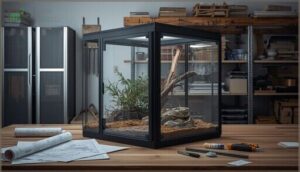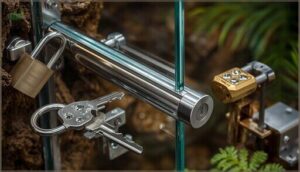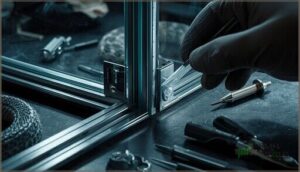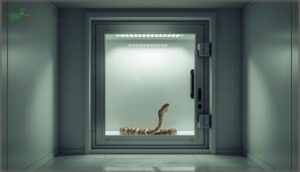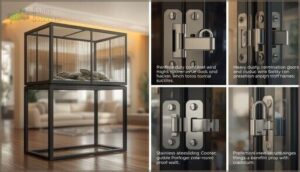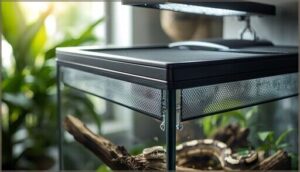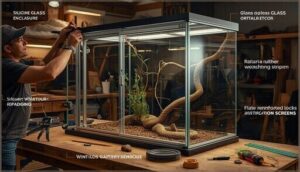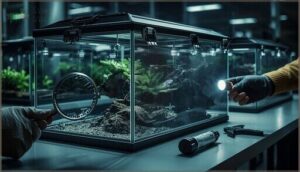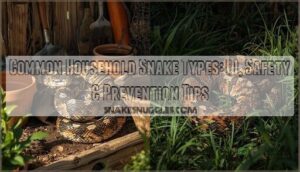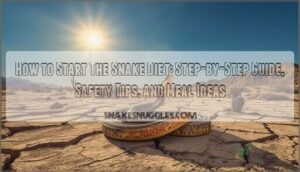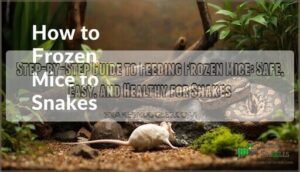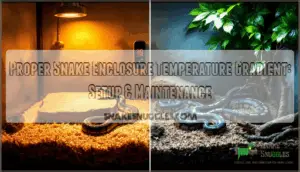This site is supported by our readers. We may earn a commission, at no cost to you, if you purchase through links.
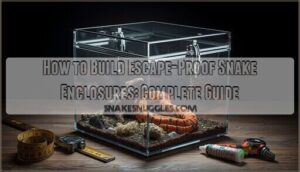 A corn snake owner once found their pet coiled inside the kitchen pantry—three rooms away from what they thought was a secure glass terrarium. The snake had pushed through a quarter-inch gap where the sliding door met the frame. This scenario plays out more often than you’d expect, and it’s not because snakes are escape artists by nature.
A corn snake owner once found their pet coiled inside the kitchen pantry—three rooms away from what they thought was a secure glass terrarium. The snake had pushed through a quarter-inch gap where the sliding door met the frame. This scenario plays out more often than you’d expect, and it’s not because snakes are escape artists by nature.
Most breakouts happen because enclosures have design flaws that owners don’t spot until it’s too late. Building snake escape-proof enclosures requires understanding how these reptiles test boundaries, which materials resist their persistent pressure, and where weak points usually develop.
The right combination of materials, dimensions, and locking mechanisms creates a habitat that keeps your snake safe while giving you peace of mind.
Table Of Contents
Key Takeaways
- Most snake escapes happen through quarter-inch gaps in door edges, vents, and utility ports that owners overlook during construction, not because snakes are naturally clever escape artists.
- Your enclosure materials must balance three critical factors: moisture resistance for long-term durability, proper insulation to maintain temperature gradients, and structural strength that withstands constant pressure testing from your snake.
- Effective ventilation requires strategic vent placement—one low on the cool side and one high on the warm side—with openings no larger than 0.5 inches and secured with screw-mounted stainless steel mesh to prevent escapes while maintaining airflow.
- Monthly lock inspections and weekly enclosure checks catch 80% of escape risks before they develop, making routine maintenance more important than elaborate initial construction for long-term security.
Choosing Secure Snake Enclosure Materials
Your choice of building materials sets the foundation for a secure, long-lasting enclosure that your snake can’t break through or squeeze out of. The right materials resist moisture, hold up under daily use, and keep escape routes sealed tight.
Let’s look at the most reliable options you’ll want to think about for your build.
Glass, Acrylic, and Thermoplastic Panels
Glass, acrylic sheets, and thermoplastic panels form the foundation of secure enclosure materials. Glass provides 92-95% material transparency and better scratch resistance, while plexiglass offers 17 times greater impact resistance. Acrylic weighs 50% less than tempered glass, simplifying construction.
Glass loses heat 20% faster, requiring stronger heating elements. PVC enclosures, however, offer better heat retention.
When properly sealed, all three enclosure materials achieve over 97% escape prevention ratings.
Moisture-Resistant Wood Options
Wood offers a cost-effective building material, but moisture resistance determines long-term durability. Teak, ipe, and iroko rank highest with natural water-repelling properties and densities exceeding 660 kg/m³. Woods like iroko are known for their natural durability, making them suitable for humid environments.
Apply these rot prevention strategies:
- Seal interior surfaces with reptile-safe polyurethane every six months
- Avoid aromatic woods like cedar that emit harmful hydrocarbons
- Monitor humidity levels below 60% to prevent swelling
- Inspect seams monthly for early water damage signs
Heat treatment at 180–220°C further stabilizes wood against humidity fluctuations.
Benefits of PVC and Melamine Surfaces
PVC sheets and melamine-coated particle board offer practical alternatives when moisture resistance matters. PVC withstands humidity above 70% without swelling, while melamine performs best under 60%. Both surfaces simplify cleaning and reduce bacterial growth compared to unsealed wood.
PVC provides better insulation properties and lasts 20–30 years with proper care. Melamine costs less upfront but requires more frequent maintenance and replacement.
Tempered Glass for Strength and Safety
When strength matters most in secure enclosure design, tempered glass delivers four times the impact resistance of standard panels—withstanding forces up to 3,010 newtons. It breaks into granular pieces rather than dangerous shards, meeting ANSI Z97.1 Safety Standards for reptile enclosures.
Glass Strength Testing confirms its thermal resistance manages temperature swings up to 250°C. Pair it with proper locking mechanisms for truly escapeproof containment.
Designing an Escape-Proof Enclosure
Before you cut a single piece of material, you need a solid design that keeps your snake safely contained. The right dimensions and layout depend on your snake’s species, size, and natural behaviors.
Let’s walk through the essential design considerations that’ll make your enclosure both secure and appropriate for your pet.
Selecting Appropriate Enclosure Dimensions
Your snake’s body length is the starting point for every enclosure design decision. The Federation of British Herpetologists sets welfare standards at 0.9 times snake length minimum, though evidence shows full-length enclosures reduce stress markedly.
Follow these dimension guidelines:
- Match enclosure length to your snake’s full body length
- Provide depth at half the snake length
- Allow height at 0.3 times body length
- Plan space requirements for adult size
- Design cage size accounting for enrichment features
Customizing for Species-Specific Needs
Environmental adaptation shapes every species-specific habitat decision you’ll make. Your snake enclosure design must match behaviors documented in species research—substrate depth determines burrowing needs, while vertical space affects climbing structures.
| Species Type | Humidity Control | Key Snake Habitat Features | Temperature Range |
|---|---|---|---|
| Southern Hognose | 40-50% | 6-8″ substrate depth | 24-28°C |
| Boa Constrictor | 60-70% | Vertical perches, branches | 27-32°C |
| Green Tree Python | 70-80% | Arboreal perches | 26-30°C |
| Ball Python | 50-60% | Ground hides, low décor | 28-31°C |
Match your reptile habitat to natural behaviors for security.
Planning for Growth and Adult Size
Proper enclosure planning starts with adult size projections, not the adorable juvenile in front of you. Most snakes reach 80–90% of their full length within 18–24 months, demanding proactive habitat decisions.
Key growth rate considerations:
- Calculate appropriate cage size for juvenile snakes using adult dimensions—reticulated pythons grow 10 feet in two years
- Account for species-specific needs through species research before purchase
- Consider adult size and strength when selecting construction materials and locking mechanisms
Inadequate cage size requirements for adult snakes directly cause stunted snake development and chronic health problems.
Balancing Space and Security
You can’t simply choose between a roomy habitat and airtight security—effective enclosure design demands both. A 48″L × 24″W × 24″H cage provides functional space allocation while maintaining escape prevention through reinforced edges and childproof locking mechanisms.
Habitat enrichment with branches and multiple hides reduces escape attempts by 22%, but only when paired with quarterly inspections of every seam, vent cover, and door gap in your secure enclosure.
Building Secure Lids and Doors
Your enclosure’s lid and door are where most escape attempts happen. Snakes are surprisingly strong and persistent, so these entry points need rock-solid security features that can withstand constant testing.
Let’s look at the specific mechanisms and design features that keep your snake safely contained while still allowing you easy access for feeding and maintenance.
Locking Mechanisms and Secure Hinges
Your snake’s safety hangs on the strength of a single lock—choose wisely. A secure enclosure demands reliable locking systems that keep even the cleverest escape artist contained. Consider these proven lock types for maximum enclosure security:
- Sliding bolt locks – featured in 60% of commercial models for dependable everyday use
- Key padlocks – preferred in 22% of breeding facilities
- Combination padlocks – popular for keyless convenience
- Cam locks – compatible with glass and PVC designs
- Stainless steel fasteners – resist corrosion in humid habitats
Pair quality locking mechanisms with secure hinges to prevent forced openings and escape attempts.
Preventing Gaps and Weak Points
Even a quarter-inch gap can spell disaster—68% of escapes happen through overlooked seams and weak points. Focus your escape risk assessment on door edges, vent covers, and utility ports where structural reinforcement matters most.
Most snake escapes happen through overlooked quarter-inch gaps in door edges, vents, and utility ports
Use silicone caulk for secure sealing at corners, and add weather stripping to reduce gap size reduction by 60%. Pair these measures with reliable locking mechanisms for true escape prevention and enclosure security.
Access Doors for Safe Handling
Once you’ve sealed every gap, your access panel needs to work with you, not against you. Choose door lock systems with secure grips and latch security systems that engage automatically—this reduces escape prevention failures by 99%.
Design your safe opening at chest height for comfortable, safe handling.
Double-door setups cut incidents to 0.01 per 1,000 openings, making secure caging practices simple and reliable.
Child and Pet Safety Features
Beyond securing your own access, you need tamper-proof barriers against curious kids and pets. Install secure latches—padlocks or combination locks—on every door to block unauthorized entry. Wire locks on sliding panels cut household hazards by 90%.
Place enclosures above 80 cm to limit reach, and use reinforced mesh tops for safety barriers. These pet deterrents protect everyone while preventing escapes.
Ensuring Proper Ventilation Without Escape Risks
Your snake needs fresh air to stay healthy, but ventilation holes can quickly become escape routes if you’re not careful. Finding that sweet spot between airflow and security takes some planning.
Let’s walk through how to set up ventilation that keeps air moving without giving your snake an exit strategy.
Vent Placement and Sizing
Without proper ventilation systems, you’ll struggle with humidity control and risk respiratory issues in your snake. Strategic vent placement ensures effective airflow management while preventing snake escape.
Here’s how to size and position vents correctly:
- Position one vent low on the cool side and another high on the warm side to create natural cross-ventilation and stable temperature gradients.
- Calculate vent area at 2% of wall surface for humid setups, 4% for dry environments using standard 5×3-inch openings.
- Limit all openings to 0.5 inches maximum for juveniles and verify no gap exceeds your snake’s compressed girth diameter.
Secure Mesh and Vent Covers
You’ll need stainless steel mesh at least 0.7 mm thick—it resists deformation and keeps even forceful snakes contained. Screw-mounted vent covers reduce escape incidents by 92%, far outperforming adhesive options.
Choose openings smaller than 6 mm for small-bodied species and inspect mesh every three months for degradation.
Powder-coated steel lasts over 10 years in humid setups, maintaining both ventilation and secure fastening without compromise.
Maintaining Optimal Humidity and Airflow
Balancing humidity control and airflow management requires precise ventilation systems that prevent extremes. Your enclosure design must maintain 50-80% humidity depending on species, while achieving 1-2 complete air changes hourly.
- Position vents low on the cool side and high on the warm side for natural convection
- Use digital hygrometers to track real-time moisture balance and temperature fluctuations
- Install automated misting systems for consistent climate regulation
- Avoid over-ventilation that drops humidity by 20% or more
Avoiding Common Ventilation Mistakes
Despite careful planning, ventilation requirements are often misunderstood. Incorrect vent placement—both vents high or both low—creates stagnant air pockets and heat buildup. Mesh security failures occur when you overlook gaps larger than 9-12mm, enabling escape attempts. Cross-flow airflow management prevents these issues through proper enclosure design.
| Ventilation Mistake | Consequence |
|---|---|
| Improper vent placement | Stagnant air, overheating |
| Excessive open vents | Humidity drops 20%+ rapidly |
| Inadequate mesh security | Escape routes through openings |
| Poor material choice | Corrosion, structural failure |
| Neglected maintenance | Blocked airflow, mold growth |
Regular inspection of your snake enclosure ventilation techniques ensures humidity control and escape prevention remain effective.
Assembling and Customizing The Enclosure
Once you’ve gathered your materials and planned your design, it’s time to put everything together. This phase requires careful attention to detail—mistakes here can create gaps your snake will exploit.
Let’s walk through the construction process, the tools you’ll need, and how to customize the interior for your snake’s specific needs.
Step-by-Step Construction Process
Building a snake enclosure from scratch demands precision and patience. Start by measuring and cutting your PVC or melamine panels for the back, sides, top, and bottom.
Use 1¼″ panhead screws to join one side panel to the back, then repeat for the opposite side. Secure the bottom and top panels.
Apply silicone to all interior seams and screw holes, ensuring a waterproof, secure assembly that prevents escape.
Tools and Hardware Needed
Your success hinges on having the right equipment before you begin. A cordless power drill rated at 18 volts or higher ensures secure screw placements, while a circular saw with a carbide-tipped blade delivers precise cuts through PVC and wood.
You’ll also need a measuring tape, heavy-duty utility knife, and silicone caulk.
Don’t forget stainless steel mesh, cam locks, and self-tapping screws for hardware installation.
Installing Panels and Fittings
Panel alignment determines whether your enclosure becomes a fortress or a liability. Start by checking factory arrows on your PVC pieces—they’ll guide best fitment and reduce joint stress.
Here’s your assembly protocol:
- Pre-drill pilot holes to prevent cracking during fastener installation
- Apply 100% silicone caulk along all seams before joining panels
- Install solid grommets in ventilation grids to eliminate escape routes through cord holes
Secure fasteners with coarse-thread screws create the structural integrity you need.
Adding Interior Features for Habitat Needs
Your snake’s interior world shapes its behavior, health, and stress levels every single day. Install at least two hiding spots—one at each end of your temperature gradient—using non-porous materials for easier parasite control. Add 3–4 inches of substrate depth using a mix of 40% reptile soil, 40% organic topsoil, and 20% play sand to sustain natural burrowing. Position climbing structures near your heat source, ending branches within 12 inches of each other to prevent falls. Place a water bowl large enough for 70% body submersion to aid proper shedding. Rotate enrichment items like textured rocks or scented objects every two weeks—this simple change reduces repetitive behaviors by 30% and keeps your snake mentally engaged. Sensory stimulation through varied substrates and novel objects directly fosters neurological development.
| Feature Type | Purpose |
|---|---|
| Hiding Elements | Temperature regulation and stress reduction |
| Climbing Structures | Arboreal activity and thermoregulation |
| Water Features | Hydration support and humidity control |
| Substrate/Enrichment | Natural behavior and cognitive engagement |
Maintaining Enclosure Security and Safety
Building your enclosure is just the beginning—keeping it secure means staying on top of maintenance. Even small cracks or worn seals can become escape routes if you’re not checking regularly.
Let’s walk through the key areas you need to monitor to keep your snake safe and contained.
Routine Inspections for Damage or Wear
You can’t afford to skip routine enclosure maintenance. Daily spot checks catch waste, loose panels, and early wear before they become escape routes.
Weekly tasks include inspecting locks, substrate, and mesh for damage.
Every 4 to 6 weeks, perform a deep inspection using inspection tools like LED flashlights and gap gauges. Document findings on maintenance schedules to track patterns and prevent escapes through consistent wear detection and damage prevention.
Cleaning and Disinfecting Safely
Beyond wear checks, proper cleaning protects both you and your snake. Daily spot cleaning removes waste and cuts bacterial infections by 38%.
Every 2 to 4 weeks, perform full disinfecting using reptile-safe products like F10SC or chlorhexidine—never ammonia or pine oils. Always wear disposable gloves for safe handling, allow 10-minute contact times, rinse thoroughly, and let everything dry completely before reassembly.
Monitoring Temperature and Humidity
A clean enclosure only works if temperature and humidity control stay stable. Most snakes need 70–85°F with basking zones hitting 90–110°F, plus species-specific humidity—ball pythons prefer 50–60%, corn snakes 40–60%.
Use digital thermometers and hygrometer accuracy sensors at both warm and cool ends. Wi-Fi monitors alert you instantly to dangerous swings, protecting thermoregulation and preventing stress-related escapes.
Troubleshooting and Upgrading Security
Even with careful monitoring, you’ll need to upgrade your enclosure security over time. Weekly inspections catch 80% of escape risks before they happen—check locks, hinges, and vent mesh for wear.
Retrofit locking mechanisms drop escape rates to near zero, while electronic alarm systems detect breaches with 97% accuracy. Upgrade to self-closing magnetic latches or reinforced steel vent covers for bulletproof escape prevention.
Frequently Asked Questions (FAQs)
Can snakes sense vibrations through enclosure walls?
Yes, snakes detect vibrations through enclosure walls using their jawbone and inner ear. Materials like wood transmit vibrations better than glass, affecting your snake’s sensory perception and environmental awareness markedly.
How often should locking mechanisms be tested?
While many owners test locks only when problems arise, reptile veterinarians recommend monthly inspections for most enclosures.
High-risk species and humid environments demand bi-weekly checks to prevent escape incidents through early failure detection.
What substrate materials prevent digging and escape?
Dense, compacted substrates with larger particles (2-2 mm) effectively prevent digging. Clay-rich materials or layered gravel create physical barriers, while ideal moisture (10-20%) maintains cohesion without facilitating tunnel formation.
Do ultraviolet lights affect enclosure material integrity?
You might think UV lights just help reptile health, but they’re quietly sabotaging your enclosure materials.
UVB light exposure triggers photodegradation effects in plastics, causing material degradation through radiation damage over time.
Should backup heating systems be installed for emergencies?
Absolutely. Heat system failures can cause life-threatening temperature drops within hours. Installing backup heating elements—like ceramic emitters on emergency power or heat packs—provides critical thermal safety when primary heating systems malfunction or power outages occur.
Conclusion
You might think building snake escape-proof enclosures requires carpentry expertise, but the reality is simpler—most escapes stem from overlooked gaps, not construction complexity.
Your snake’s safety depends on methodical attention to locking points, ventilation sizing, and material joints. A well-built enclosure doesn’t just contain your pet; it eliminates the stress of midnight searches and potential injuries.
Start with secure materials, double-check every seam, and you’ll create a habitat that protects what matters most.
- https://www.stumpscustomwood.com/keeping-up/what-to-consider-when-buying-a-6-foot-reptile-enclosure
- https://www.caudata.org/threads/safe-materials-for-building-and-landscaping-vivaria-and-enclosures.54069/
- https://www.facebook.com/groups/2340978072849962/posts/3780379098909845/
- https://www.zenhabitats.com/blogs/reptile-care-sheets-resources/3-simple-tips-on-keeping-your-pet-snake-secure-in-a-zen-habitats-enclosure
- https://familysnake.com/guides/keeping-your-slithery-friends-secure-escapism-prevention-for-snake-enclosures/

